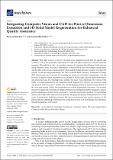Integrating Computer Vision and CAD for Precise Dimension Extraction and 3D Solid Model Regeneration for Enhanced Quality Assurance
Author(s)
Bhandari, Binayak; Manandhar, Prakash
Downloadmachines-11-01083.pdf (5.331Mb)
Publisher with Creative Commons License
Publisher with Creative Commons License
Creative Commons Attribution
Terms of use
Metadata
Show full item recordAbstract
This paper focuses on the development of an integrated system that can rapidly and accurately extract the geometrical dimensions of a physical object assisted by a robotic hand and generate a 3D model of an object in a popular commercial Computer-Aided Design (CAD) software using computer vision. Two sets of experiments were performed: one with a simple cubical object and the other with a more complex geometry that needed photogrammetry to redraw it in the CAD system. For the accurate positioning of the object, a robotic hand was used. An Internet of Things (IoT) based camera unit was used for capturing the image and wirelessly transmitting it over the network. Computer vision algorithms such as GrabCut, Canny edge detector, and morphological operations were used for extracting border points of the input. The coordinates of the vertices of the solids were then transferred to the Computer-Aided Design (CAD) software via a macro to clean and generate the border curve. Finally, a 3D solid model is generated by linear extrusion based on the curve generated in CATIA. The results showed excellent regeneration of an object. This research makes two significant contributions. Firstly, it introduces an integrated system designed to achieve precise dimension extraction from solid objects. Secondly, it presents a method for regenerating intricate 3D solids with consistent cross-sections. The proposed system holds promise for a wide range of applications, including automatic 3D object reconstruction and quality assurance of 3D-printed objects, addressing potential defects arising from factors such as shrinkage and calibration, all with minimal user intervention.
Date issued
2023-12-12Department
Sloan School of ManagementPublisher
Multidisciplinary Digital Publishing Institute
Citation
Machines 11 (12): 1083 (2023)
Version: Final published version